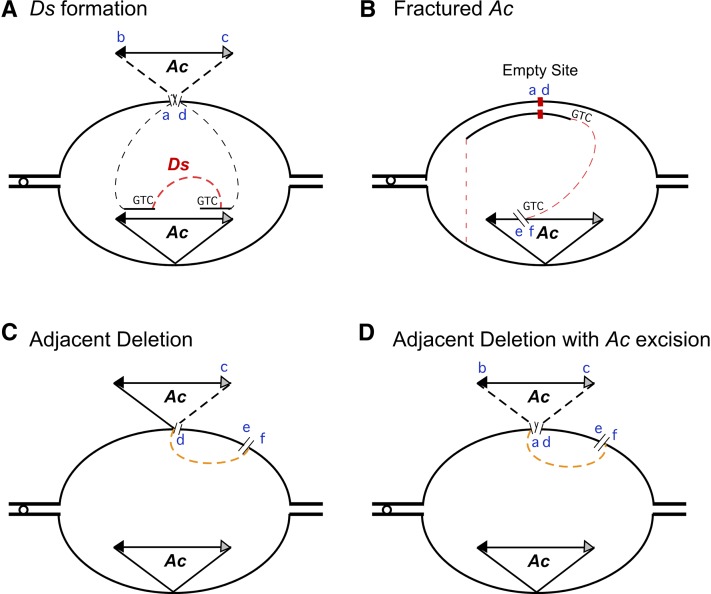Figure 9.
Models for the Origin of the Various Ac Mutations.
The diagrams illustrate DNA replication bubbles during chromosome replication and the aberrant repair of Ac-induced DSBs that leads to the formation of Ac mutations. The TE 5′ ends are represented as solid arrowheads, and the 3′ ends are represented as hatched ones. In each transposition reaction, the Ac transposase makes three cuts, one at each TE end to be mobilized and one at the receptor site, and generates six cut ends (a to f), as follows: a, host DNA adjacent to TE 5′ end; b, TE 5′ end; c, TE 3′ end; d, host DNA adjacent to TE 3′ end; e and f, host target site. The GTC trinucleotide sequences represent sites of microhomology in (A) and (B). Red dotted lines represent synthesis-dependent MMEJ–mediated ([A] and [B]) mutational events, and orange dotted lines represent NHEJ–mediated ([C] and [D]) mutational events. The dotted lines in the Ac triangle ([A] and [D]) indicate discontinuity between Ac and the host chromosome.
(A) DSB repair of the Ac excision site is initiated with strand invasion of the sister chromatid by the a and d cut ends to begin copying Ac. MMEJ between the two GTC repeats leads to the formation of an internally deleted Ds element.
(B) In an aborted Ac transposition to the Ac element in the sister chromatid, the f end of the receptor site cut invades the sister chromatid at a site of microhomology (GTC) near the NHEJ-repaired a to d excision site. DNA repair synthesis and eventual return to the original chromatid result in the formation of a fractured Ac and a duplication of Ac-adjacent DNA.
(C) An aberrant transposition resulting from noncleavage or rejoining of the a to b site leads to the formation of a typical c to f transposition junction, but loss of the fragment between Ac and the e to f receptor site.
(D) An aberrant ligation of the host a and f cut ends at the excision and receptor sites, respectively, leads to loss of Ac and the fragment between Ac and the receptor site.

